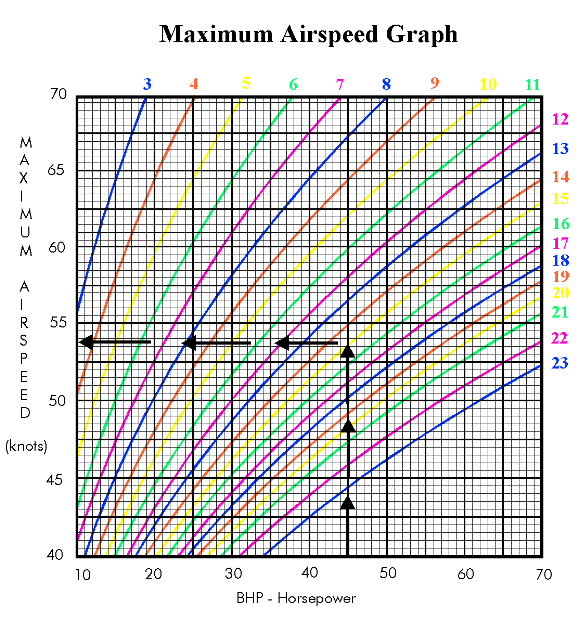
APPENDIX 1. DETERMINING MAXIMUM LEVEL FLIGHT AIRSPEED OF ULTRALIGHTS.

APPENDIX 1. DETERMINING MAXIMUM LEVEL FLIGHT AIRSPEED OF ULTRALIGHTS.
The information contained in this appendix is intended to assist in a determination
of an ultralight's capability to comply with Section 103.1(e)(3). The maximum speed
of an ultralight as computed with this information may be accepted as a portion of
the "satisfactory evidence" specified in Section 103.3(b). When using this information,
additional drag factors should be considered and no extra value should be
given any of the factors provided. There is already a "cushion" built into the
computation to account for the factors affecting the maximum speed capability of an
ultralight. No drag-producing element should be counted under more than one drag
factor category.
STEP ONE - Compute the total drag factor (See page 2 for further breakdown of the
values assigned to each category.)
1. Pilot Drag Factor (Select one)................................... ________
*Not Enclosed
-prone ................................ 1.2
-supine ................................ 4.5
-seated upright ......................... 5.5
*Partially Enclosed
-lower half of body enclosed ............ 3.5
-only head exposed ...................... 2.5
-streamlined, head behind windshield..... 2.0
*Totally Enclosed
-streamlined fuselage ................... 1.5
-boxy fuselage .......................... 2.0
2. Wing Drag Factor (total square feet of upper
surface = ______ x 0.01) ..................................... ________
3. Stabilizing & Control Surface Drag Factor (total square
feet of one side of each surface = ___________ x 0.014) ....... ________
4. Exposed Wire Drag Factor (total wires over 4 feet long and
45 to 90 degrees to airflow = ________ x 0.05) ................ ________
5. Exposed Struts Drag Factor (total struts over 4 feet long
and 45 to 90 degrees to airflow [excluding those associated
with landing gear] _________ x 0.4) ........................... ________
6. Landing Gear Drag Factor (includes associated struts)
*Faired, fixed gear (number of wheels = _________ x 0.3)
*Unfaired, fixed gear (number of wheels = _________ x 0.5)
7. Engine Drag Factor (select one) ................................. ________
*completely exposed = 2.5
*partially exposed = 1.5
*some components exposed = 0.5
8. SUBTOTAL ABOVE DRAG FACTORS ..................................... ________
9. SUBTOTAL OF DRAG FACTORS FROM PREVIOUS PAGE .................... ________
10. Allowance for Induced and Interference Drag (multiply subtotal
of drag factors x .20) ............................... ________
11. COMPUTED TOTAL DRAG FACTORS (add items 9 and 10) ................ ________
CONSIDERATIONS IN ASSIGNMENT OF DRAG FACTOR VALUES:
- Pilot drag factors. "Supine" is a sitting position with the legs extended
forward, nearly in line with the lower part of the body. "Seated upright" is a
sitting position where the lower legs extend downward. "Only head exposed" includes
all semi or fully streamlined vehicles having a small windshield which does not
deflect the airflow away from the pilot's face. "Streamlined, head behind windshield"
includes those ultralights which, from a viewing position in front of the
vehicle, the pilot's body is not exposed to the airflow. Where a two-place vehicle
s being operated under an exemption, side-by-side seating doubles the factor for
he fully-exposed groupings and the "lower half of body enclosed" category. No
additional credit is given for the other categories under partially or fully exposed.
Also, no additional credit is given to tandem arrangements.
- Wing drag. This includes all horizontal flying surfaces, including canards (but
excluding any other stabilizing or control surface). The total square feet of upper
surface of the wing, as determined from a manufacturer's specification or through
rough measurement (length x width) is used in this calculation.
- Stabilizing and control surface drag. This includes horizontal and vertical
stabilizers, rudders, elevators, and ailerons. The total square feet of exposed
surfaces (one side only) is used in this calculation.
- Exposed wire and strut drag. The number of wires or struts, not associated with
he landing gear, which are OVER 4 FEET LONG with an angle of 45 TO 90 DEGREES TO
THE AIRFLOW are counted and multiplied times the given values. Those wires and/or
struts located behind the pilot/engine/wing (usually making up portions of the rear
fuselage or empenage) are not counted. Wires or struts located parallel to and behind
other wires or struts in the airflow are not counted if they do not flare uniformly
away from any common attaching point, achieving a minimum separation of at least
inches.
- "Fixed" landing gear drag. Regardless of size of wheels or length of struts,
the values shown in the chart are applicable. "Faired" wheels are those which have
one-third or more of the wheel surface covered in the front and on the sides.
- Engine drag. Engines in. front of the wing without fairing and those in back,
which protrude noticeably into the airflow above or below the wing, are considered
completely exposed. Those with streamlined fairings not located in the fuselage or
behind a semi.streamlined pilot cockpit are considered partially exposed. Faired
engines positioned in the front or rear of a fully streamlined fuselage with
components such as air filters and mufflers exposed are treated under "some components
exposed." Faired or unfaired engines located in the turbulent area directly
behind the pilot's body or the vehicle's fuselage are also considered under this
grouping.
STEP TWO - Determine the maximum airspeed of the vehicle through the use of the
chart below.
INSTRUCTIONS:
- Enter the bottom of the chart at the engine manufacturer's maximum
horsepower rating of the installed engine. (Example: 45 horsepower).
- Proceed directly up the horsepower line until encountering the
total drag factor curve computed for the ultralight (Example: 15).
- Note horizontal line which also intersects at that point, proceed
to the left along that line to the edge of the graph, read maximum
airspeed (Example: 53.5).

 Back to the Ultralight home page
Back to the Ultralight home page
 Jon N. Steiger / stei0302@cs.fredonia.edu / SUNY College at Fredonia
Jon N. Steiger / stei0302@cs.fredonia.edu / SUNY College at Fredonia


 Back to the Ultralight home page
Back to the Ultralight home page